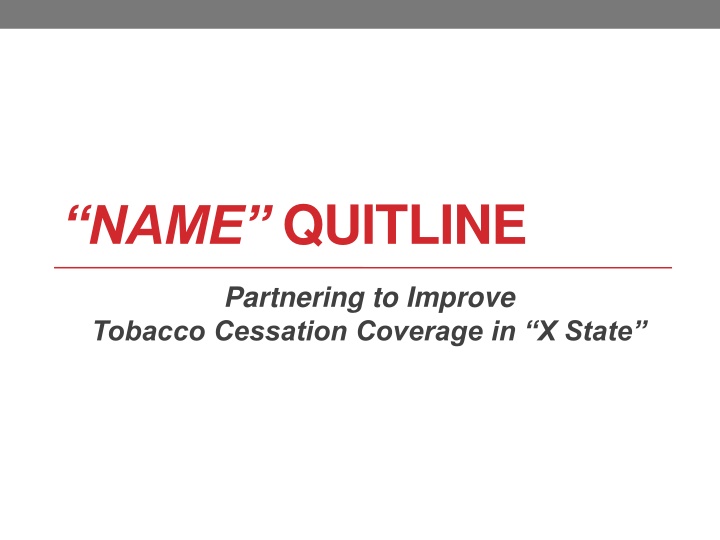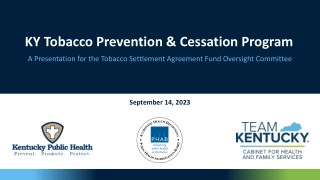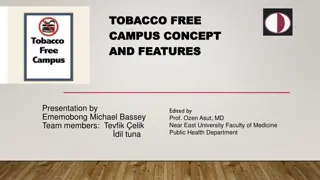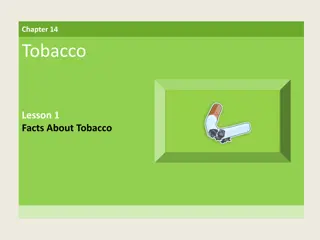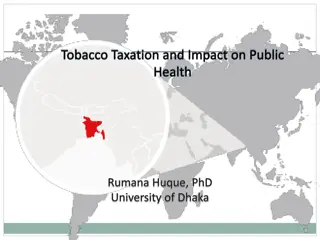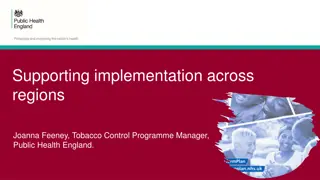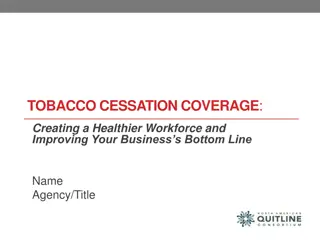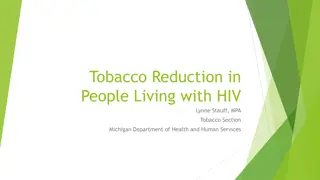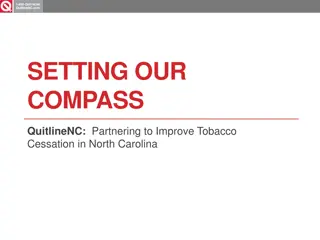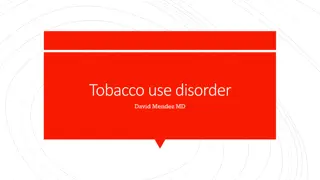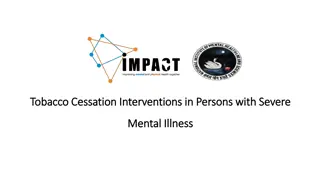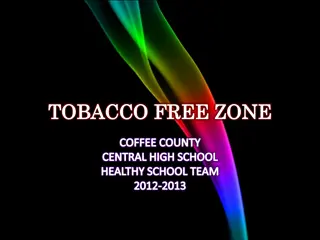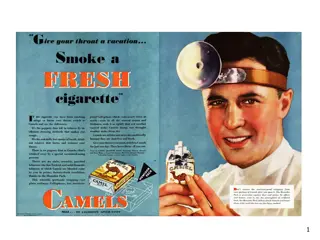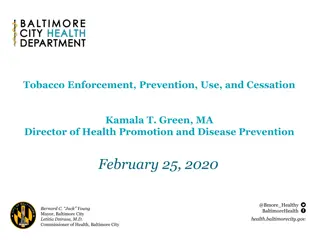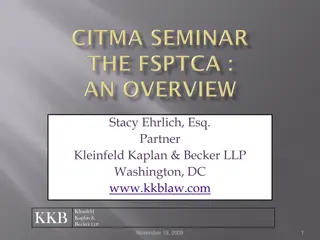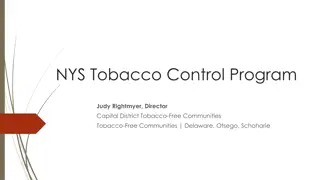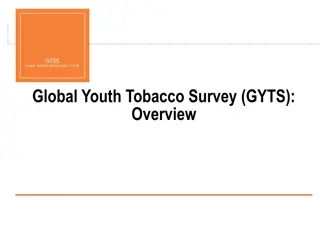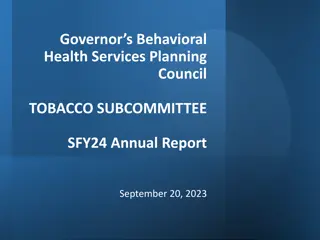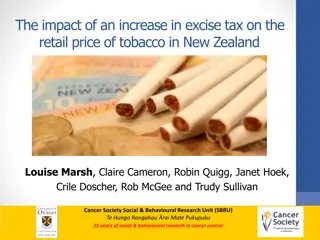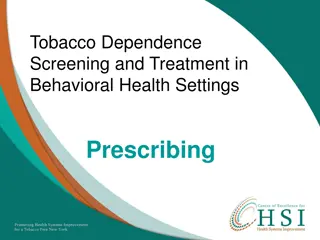Partnering to Improve Tobacco Cessation Coverage in X State
This presentation focuses on addressing the issue of tobacco use and the gaps in cessation treatment for State employees. It discusses the costs of tobacco use, the benefits of tobacco cessation coverage, and the ACA requirements for insurers. It also explores opportunities for collaboration to expand cessation coverage statewide and accelerate the national movement to reduce tobacco use. The presentation emphasizes providing barrier-free tobacco cessation treatments to all smokers, especially those with comorbidities, and highlights the financial impact of smoking-related illnesses on the United States.
Download Presentation

Please find below an Image/Link to download the presentation.
The content on the website is provided AS IS for your information and personal use only. It may not be sold, licensed, or shared on other websites without obtaining consent from the author.If you encounter any issues during the download, it is possible that the publisher has removed the file from their server.
You are allowed to download the files provided on this website for personal or commercial use, subject to the condition that they are used lawfully. All files are the property of their respective owners.
The content on the website is provided AS IS for your information and personal use only. It may not be sold, licensed, or shared on other websites without obtaining consent from the author.
E N D
Presentation Transcript
NAME QUITLINE Partnering to Improve Tobacco Cessation Coverage in X State
Presentation Objectives Demonstrate the problem of tobacco use and gaps in cessation treatment for State employees. Understand the costs of tobacco use. Demonstrate cost-effectiveness of tobacco cessation coverage. Clarify the ACA requirements for tobacco coverage for insurers. Share the benefits and options for partnering with the State Quitline . Identify opportunities for collaboration to expand cessation coverage and treatment statewide.
Accelerating the National Movement to Reduce Tobacco Use Provide access to barrier-free proven tobacco use cessation treatment including counseling and medication to all smokers, especially those with significant mental and physical comorbidities. Expand smoking cessation for all smokers in primary and specialty care settings by having health care providers and systems examine how they can establish a strong standard of care for effective treatments. U.S. Department of Health and Human Services. The Health Consequences of Smoking 50 Years of Progress: A Report of the Surgeon General. Atlanta, GA: U.S. Department of Health and Human Services, Centers for Disease Control and Prevention, National Center for Chronic Disease Prevention and Health Promotion, Office on Smoking and Health, 2014.
Tobacco Dependency in State 25 20.4 20 19 20 18.5 18 16.5 16 15 Percentage 10 5 0 2008 2009 2010 2011 2012 2013 2014 2015
StateTobacco Users Want to Quit (and need help) % of State tobacco users made a serious but failed attempt to quit smoking in insert year
Costs Associated with Smoking Cost of Smoking-Related Illness Smoking-related illness in the United States costs more than $300 billion each year, including: Nearly $170 billion for direct medical care for adults1 More than $156 billion in lost productivity, in addition to $5.6 billion in lost productivity due to secondhand smoke exposure2 1Xu X, Bishop EE, Kennedy SM, Simpson SA, Pechacek TF. Annual Annual Healthcare Spending Attributable to Cigarette Smoking: An Update[PDF 157 KB]. American Journal of Preventive Medicine 2014;48(3):326 33 [accessed 2015 Apr 7]. 2U.S. Department of Health and Human Services. The Health Consequences of Smoking 50 Years of Progress: A Report of the Surgeon General. Atlanta: U.S. Department of Health and Human Services, Centers for Disease Control and Prevention, National Center for Chronic Disease Prevention and Health Promotion, Office on Smoking and Health, 2014 [accessed 2015 Apr 3].
Tobacco Use Costs Employers It is estimated that US businesses incur excess costs in the range of $5,816 per year.1 On average, smokers miss 2.74 more days of work per year compared to non-smokers.2 The annual per smoker cost of lost productivity due to unsanctioned smoking breaks is $3,077.24.1 Businesses pay an average of $2,289 in workers compensation costs for smokers, compared to $176 for nonsmokers.3 1Berman M., Crane R., Seiber E., Munur M. Estimating the cost of a smoking employee. TobControl 2013; 0:1-6. 2Weng S.F.,Ali S., Leonardi-Bee J. Smoking and absence from work: Systematic review and meta-analysis of occupational studies. Addiiction 2012; 108: 307-319. 3Musich S, Napier D, Edington D. The association of health risks with worker s compensation costs. JOEM. 2001:43 (6):534-541.
Cessation Coverage: Benefits Over time, tobacco-use cessation benefits generate financial returns for employers in four ways: Reduced health care costs 1,2 Reduced absenteeism 1,3 Increased on the job productivity 1,3 Reduced life insurance costs 1,3 Coverage of tobacco-use cessation treatment (counseling and medications) increases the chance of a successful quit.4 Cost analyses have shown that tobacco cessation benefits, from an employer perspective, are cost-saving.5 1Warner KE, Smith RJ, Smith DG, Fries BE. Health and economic implications of a work-site smoking-cessation program: a simulation analysis. Journal of Occupational and Environmental Medicine 1996;38(10):981 92. 2Wagner EH, Curry SJ, Grothaus L, Saunders KW, McBride CM. The impact of smoking and quitting on health care use. Archives of Internal Medicine 1995;155(16):1789 015 015 95. 3 Halpern MT, Shikiar R, Rentz AM, Khan ZM. Impact of smoking status on workplace absenteeism and productivity. Tobacco Control 2001;10:233 8. 4Moehle McCallum D, Fosson GH, Pisu M. Making the case for Medicaid funding of smoking cessation treatment programs:an application to state-level health care savings. Journal of Health Care for the Poor and Underserved, 2014; 25(4): 1922-1940. 5Campbell KP, Lanza A, Dixon R, Chattopadhyay S, Molanari N, Finch RA, editors. A purchaser s guide to clinical preventive services: moving science into coverage. Washington, DC: National Business Group on Health; 2006.
Paying for an employees tobacco cessation treatment provides more return on investment than any other adult treatment or prevention benefit. National Business Group on Health
Massachusetts Medicaid Program After two and half years of offering comprehensive coverage for pharmacotherapy and counseling smoking rates dropped from 38% to 28%1 hospital claims for acute heart attacks dropped by 46% and coronary heart disease dropped by 49%2 Medical savings to the Medicaid program of $3.12 for every $1.00 spent (ROI of $2.12)3 1Land, T, Warner, D, Paskowsky, M, et al. Medicaid coverage for tobacco dependence treatments in Massachusetts and associated decreases in smoking prevalence. PLoSONE 2010 March;5(3): e9770. 2Land, T, Rigotti, NA, Levy, DE, et al. A longitudinal study of Medicaid coverage fortobacco dependence treatments in Massachusetts and associated decreases in hospitalizations for cardiovascular disease. PLoS Med 2010 Dec;7(12): e1000375. 3 Richard, P, West, K, Ku, L. The return on investment of a Medicaid tobacco cessation program in Massachusetts. PLoS ONE 2012 Jan;7(1): e29665.
Return-On-Investment for an Employer Tobacco-dependence treatment is highly cost-effective and cost-saving.1 The return-on-investment for tobacco cessation treatment has been shown to be positive after one year due to increases in employee productivity alone.2 Recent studies have shown that medical cost savings within 18 months for smokers who quit compared to those who continued smoking.3,4 Up to 70% of current smokers' excess medical care costs is preventable by quitting.5 1Fiore, MC, Jaen, CR, Baker, TB, et al. Treating tobacco use and dependence: 2008 update. Clinical Practice Guideline. Rockville, MD: U.S. Department of Health and Human Services. Public Health Service, 2008. Available at: www.surgeongeneral .gov/ tobacco/ treating_tobacco_use08 .pdf. 2American Health Plan Insurance. Making the Business Case for Tobacco Cessation. Retrieved from http://www.businesscaseroi.org 3Hockenberry, JM, Curry, SJ, Fishman, PA, et al. Healthcare costs around the time ofsmoking cessation. Am J Prev Med 2012 Jun;42(6): 596 601. 4Richard, P, West, K, Ku, L. The return on investment of a Medicaid tobacco cessationprogram in Massachusetts. PLoS ONE 2012 Jan;7(1): e29665. 5Maciosek M., Xu X., Butani A., Pechacek. Smoking-attributable medical expenditures by age, sex, and smoking status estimated using a relative risk approach. Prev Med 2015; 77:162-167.
Partnering with Quitline Makes Good Sense Quitline is well recognized by providers and tobacco-users Quitline provides evidence-based services Helps meet ACA criteria It is easy to partner with Quitline Quitline is very cost-effective
ACA : Tobacco Cessation Coverage ACA Since 2010, most insurers are required to provide tobacco cessation coverage May 2014 - Guidance issued by the U.S. Departments of Health and Human Services, Labor and Treasury stating To comply with ACA, cessation benefits should include: Screening for tobacco use. Two quit attempts per year, consisting of: Four sessions of telephone, individual and group cessation counseling lasting at least 10 minutes each per quit attempt; and, All medications approved by the FDA as safe and effective for smoking cessation, for 90 days per quit attempt, when prescribed by a health care provider. Cost-sharing (i.e., copays) and prior authorization for any of these treatments should not be required.
Current State Employee Benefits Add coverage in format of ACA recommendation (previous slide Identify gaps For example: Reliance on QuitLine Tobacco cessation drugs not in formulary Plans don t include specific tobacco cessation coverage
We Know What Works Research indicates the most effective tobacco treatment is a combination of: evidence-based coaching and FDA approved medications. Quitline is evidence-based
Cessation Benefits Cessation Benefits Should Include ALL of These Treatments: Barriers to Avoid: MEDICATIONS COUNSELING Co-pays Prior authorization Duration limits Annual limits on quit attempts Dollar limits Requirements to try one medication before another Requirements to pair medications with counseling Nicotine Gum Nicotine Patch Nicotine Lozenge Nicotine Nasal Spray Nicotine Inhaler Bupropion Varenicline Individual Group Phone Helps meet ACA criteria
Mechanism to Meet the Need Quitline helps meet ACA requirements
Quitlines: Evidence-Based and Effective Quitlines are telephone-based tobacco cessation services that help tobacco users quit through a variety of services, including: Counseling FDA-approved medications Information and self-help materials Quitlines reach many smokers, even underserved and rural populations Quitline counseling can more than double a smoker s chances of quitting. 1 Quitline counseling combined with medication can more than triple the chances of quitting. 1 1Fiore MC, et al. Treating Tobacco Use and Dependence: 2008 Update Clinical Practice Guideline, US Public Health Service, May 2008, http://www.surgeongeneral.gov/tobacco/treating_tobacco_use08.pdf.
Quitlines: Evidence-Based and Effective Face-to-face counseling and interactive telephone counseling are more effective than services that only provide educational or self-help materials.1,2 The effectiveness of counseling services increases as their intensity (the number and length of sessions) increases.1 Smokers are more likely to use telephone counseling than to participate in individual or group counseling sessions.2,3 1Fiore MC, Bailey WC, Cohen SJ, et al. Treating Tobacco Use and Dependence: Clinical Practice Guideline. Rockville, MD: U.S. Department of Health and Human Services, Public Health Service; 2000. 2McAfee T, Sofian N, Wilson J, Hindmarsh M. The role of tobacco intervention in population-based health care. American Journal of Preventive Medicine 1998;14:46 52. 3McAfee T. Increasing the population impact of quitlines. Paper presented at the North American Quitline Conference, Phoenix, AZ, 2002.
Quitline Telephone Counseling Convenient More flexible than a group counseling session Accessible regardless of location Less expensive than individual face-to-face counseling Counselors trained specifically for tobacco cessation treatment based on latest research
Quitline is high quality and effective 6 Month Quit Rates Comparison 10% Physician Advice Alone* ( )% (QuitlineName)Counseling** ( )% Quitline*** Counseling & NRT *Fiore, Treating Tobacco Use and Dependence, Clinical Practice Guidelines 2008 Update ** (Reference) *** (Reference)
State Quitline Services Consists of five outbound coaching sessions and unlimited support calls. Special protocol and treatment sessions for pregnant women Highly trained, professional Quit Coaches Coaching supported in multiple languages NRT mailed directly to tobacco user s home Accessible (add state s quitline hours) Integrated with an interactive web based tobacco treatment program Online registration
Quitline Infrastructure: No Capitol Outlay Financial Benefits Infrastructure in place Quit Line set-up fees are minimal (one-time $) and minimal annual maintenance fees ($). Reporting No charge for monthly utilization reports. Plans or Employer Groups may have their members/employees who call warm transferred directly to the Plan s internal program. The charge for this is $ () /warm transfer. Plans or employer groups are charged only when a service is provided compared to a pmpm fee. It is easy to partner with Quitline
Quitline Infrastructure: No Capitol Outlay Service Benefits Externally validated 6/7 month quit rate of XX percent for insert state callers. Ability to use 1-800-QUIT-NOW which has high consumer and health care provider recognition. Individual meetings upon request. High referral rates by health care providers. Statewide quitline media campaigns and national campaigns provide free advertisement to your employees. It is easy to partner with the Quitline
Coaching Services For no more than $() per member, evidence-based comprehensive integrated telephone and internet coaching services will be provided. Quitline is very cost effective
Nicotine Replacement Therapy Costs are no more than: Four weeks Eight weeks $ $ Four weeks Eight weeks $ $ Four weeks Eight weeks $ $ Quitline is very cost effective
In Summary Providing a tobacco cessation benefit for employees is cost-effective and shown to be cost-saving. The Affordable Care Act requires insurers, including self-insured employers to provide tobacco use treatment (counseling and medication). Quitlines are an cost-effective resource for providing an evidence-based cessation treatment. Quitlines provide a wide array of services to meet an individual s need. Quitlines are accessible and have excellent outcomes.
Its Easy to Participate Agree to contract with the vendor or agency . Promote State Quitline to your employees with the assistance of our professional marketing staff. AND WE DO THE REST! It is easy to partner with the Quitlne
Contact Us Add Contact Information
